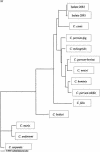Genetic characterization and transmission cycles of Cryptosporidium species isolated from humans in New Zealand
- PMID: 15240272
- PMCID: PMC444824
- DOI: 10.1128/AEM.70.7.3973-3978.2004
Genetic characterization and transmission cycles of Cryptosporidium species isolated from humans in New Zealand
Abstract
Little is known about the genetic characteristics, distribution, and transmission cycles of Cryptosporidium species that cause human disease in New Zealand. To address these questions, 423 fecal specimens containing Cryptosporidium oocysts and obtained from different regions were examined by the PCR-restriction fragment length polymorphism technique. Indeterminant results were resolved by DNA sequence analysis. Two regions supplied the majority of isolates: one rural and one urban. Overall, Cryptosporidium hominis accounted for 47% of the isolates, with the remaining 53% being the C. parvum bovine genotype. A difference, however, was observed between the Cryptosporidium species from rural and urban isolates, with C. hominis dominant in the urban region, whereas the C. parvum bovine genotype was prevalent in rural New Zealand. A shift in transmission cycles was detected between seasons, with an anthroponotic cycle in autumn and a zoonotic cycle in spring. A novel Cryptosporidium sp., which on DNA sequence analysis showed a close relationship with C. canis, was detected in two unrelated children from different regions, illustrating the genetic diversity within this genus.
Figures




References
-
- Awad-El-Kariem, F. M., H. A. Robinson, D. A. Dyson, D. Evans, S. Wright, M. T. Fox, and V. McDonald. 1995. Differentiation between animal and animal strains of Cryptosporidium parvum using isoenzyme typing. Parasitology 110:129-132. - PubMed
-
- Baker, M. 2003. Monthly surveillance reports: September 2003. [Online.] Environmental Science and Research, Ltd., Wellington, New Zealand. http://www.esr.cri.nz.
-
- Brown, T. J., G. Ionas, J. J. Learmonth, E. A. Keys, and P. A. McLenachan. 1998. The distribution of Giardia and Cryptosporidium in New Zealand waters: a nationwide study. Water Waste New Zealand 101:60-63. (Erratum, 102:58.)
-
- Caccio, S., W. Homan, K. van Dijk, and E. Pozio. 1999. Genetic polymorphism at the β-tubulin locus among human and animal isolates of Cryptosporidium parvum. FEMS Microbiol. Lett. 170:173-179. - PubMed
Publication types
MeSH terms
Substances
Associated data
- Actions
- Actions
- Actions
- Actions
- Actions
- Actions
- Actions
- Actions
- Actions
- Actions
- Actions
- Actions
- Actions
- Actions
LinkOut - more resources
Full Text Sources
Molecular Biology Databases

